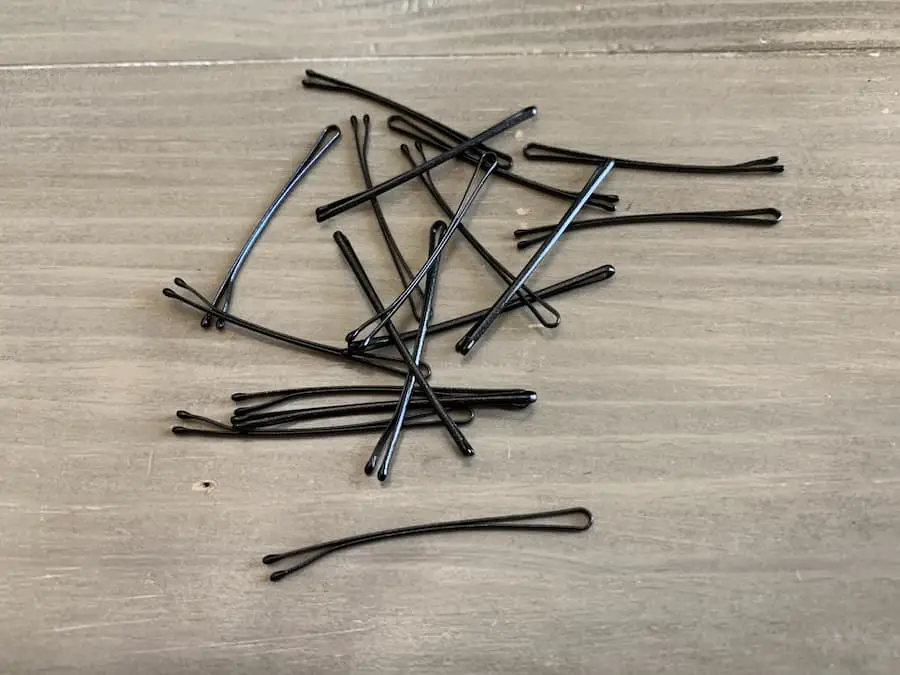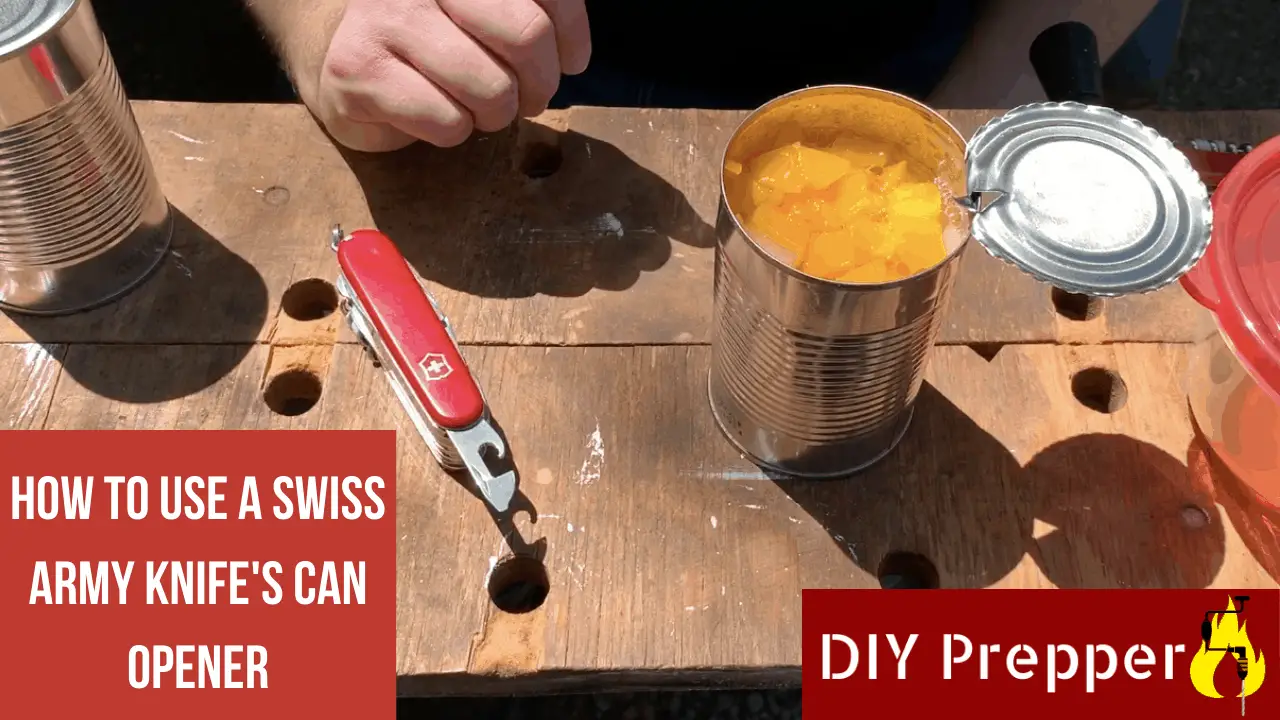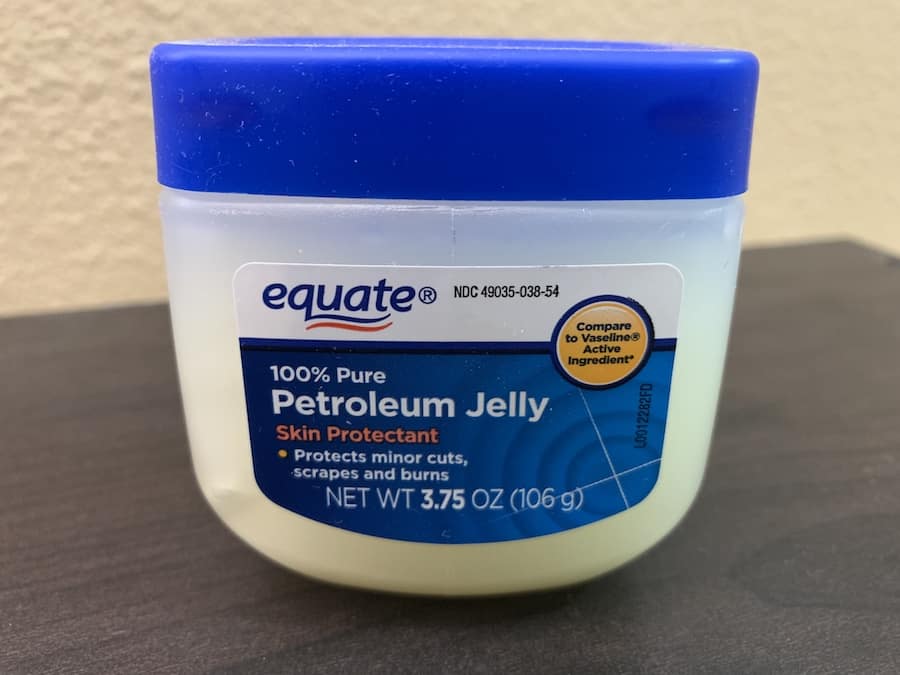31 Survival Uses for Safety Pins
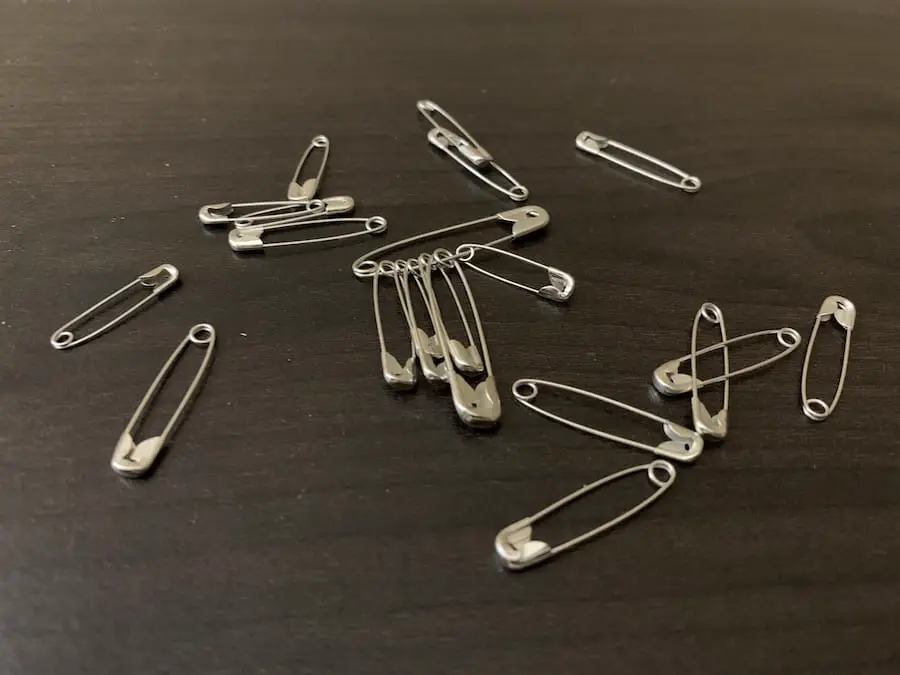
Safety pins have a wide variety of uses and can be found in almost every home. They are also essential items for bug out bags and survival kits because of their many survival uses.
Some survival uses for safety pins include:
- Creating camouflage
- Fishing hook
- Securing bait to traps and trotlines
- Creating shelter
- Repairing clothes and gear
- Gaiters
- Securing bandages
- Splinter removal
- Creating slings
- Lock picks
Below are 31 survival uses for safety pins. They can help you stay alive in an emergency and some can make your everyday life easier as well.
Camouflage
One way that you can use safety pins for survival is to create camouflage. You can use them to attach branches and other materials from your surroundings to clothing, gear, and even shelters. Using them in this way would break up the outline of whatever you are trying to disguise and help it blend into the environment much better than even store-bought camo.
Secure Bait in Traps
One challenge in creating small animal traps is setting them up so they are sensitive enough to catch an animal but not so sensitive that they go off on accident. Safety pins can help with this problem.
Use a safety pin to attach the bait to the trigger mechanism. This will make it much more difficult for the animal to remove the bait without activating the trap.
Fishing Hook
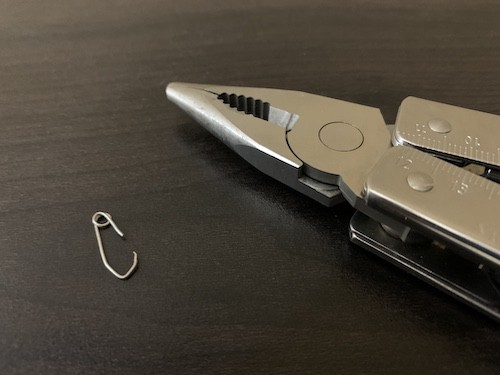
Safety pins can also be used to make survival fishing hooks, especially for small and medium-size fish. To turn a safety pin into a fish hook, start by opening it up. Then, cut off the lock.
Next, form the hook by creating a J-bend on the pointed end of the safety pin. From here you can do a couple of different things. The easiest one is simply cut off the other end at the coil. However, if you go a couple of steps further, you can help prevent the fish from getting off the hook.
You can help make the hook more effective by bending the other end of the safety pin (the one that you cut the lock off of) in, slightly past the J-bend. Then hold it with pliers right below where the coil is and bend it away from the hook at a 90-degree angle. Open it slightly and cut where you created the 90-degree bend.
You will need a good multitool to turn a safety pin into a fishing hook. While there are many options out there, I prefer the Victorinox Swisstool.
You can find my review of the Swisstool here.
Or, you can check out the Swisstool by clicking here. It is one of the most well-built multitools available. It is also more comfortable to use than any other multitool I have tried.
Secure Bait to a Trotline
If you are in a survival situation in an area with fish, setting a trotline can help you catch enough fish to stay alive. Trotlines consist of heavy fishing lines with bait attached to hooks at different locations on the line. This allows you to catch multiple fish with one piece of equipment, which is valuable when you need to conserve energy.
To do this, cut off at least 25 feet of heavy line or paracord. How much you will need will depend on where you are setting up your line. Add several dropper lines to it. Each one should be about 2 or 3 feet long and about 6 feet apart. This will get the bait below the surface of the water while preventing the dropper lines from tangling.
Use safety pins to create a fishing hook for each dropper line. Attach them to the lines and then add bait to them. Set up your finished trotline and secure it well to ensure it doesn’t float away.
Fishing Rod Repair
You can also use a safety pin to replace a missing eye on a fishing rod. Eyes are the small metal pieces that the fishing line passes through along the length of the rod. Sometimes these eyes fall off, which can be very frustrating if you don’t have a spare rod.
If this happens to you, take a safety pin and create a 90-degree bend at the coiled end of the safety pin. How far the bend is will depend on how tall the rod’s other eyes are. Then cut off the other end of the safety pin right below its lock.
Finally, use some fishing line to lash the new eye onto the rod. Be sure to get it as tight and secure as you can.
Prevent a P38 Can Opener from Opening
Everyone should have a manual can opener, whether it is included in a Swiss Army Knife, a multitool, or as a standalone P38. P38 can openers are simple and effective. Because of this, they are very popular among preppers, campers, and survivalists.
One problem with P38 can openers is that the blade tends to open inside of pockets or bags. This can be uncomfortable and damage gear. To stop this, slide a safety pin through the hinge that connects the blade to the can opener’s body. This will prevent it from opening and give you a way to carry an extra safety pin that you can use for other purposes if necessary.
Creating Shelter
Safety pins can also be used to create a shelter in a survival situation. If you have multiple tarps or pieces of canvas, you can use them to combine them to create teepees, A-frame shelters, and many other structures. When doing this, be sure that the top piece overlaps the bottom piece so that rain won’t get into the shelter where they join together. Safety pins can also be used to close shelters so that they don’t open up because of wind.
Zipper Lock
Being able to lock zippers on packs and luggage can be useful in a variety of situations. It can help protect you from opportunistic thieves who want to get into your bag quickly without being detected. Locking zippers can also prevent packs from coming unzipped while moving, saving you from losing gear.
Safety pins are excellent for this purpose, especially if you don’t have a luggage lock and need to improvise. They can be used to hold zipper locks together as well as prevent zippers from moving if they are attached to the zipper itself.
Drawstring Repair
I always hate it when a drawstring accidentally comes out of a hoodie or jacket. When this happens, you can use a safety pin to help you get it back into place. Attach the safety pin to the end of the string and slide it into the drawstring’s hole. Use it to help you run the drawstring through to the other side. You can use this if you need to replace a worn-out drawstring as well.
Replacement Button
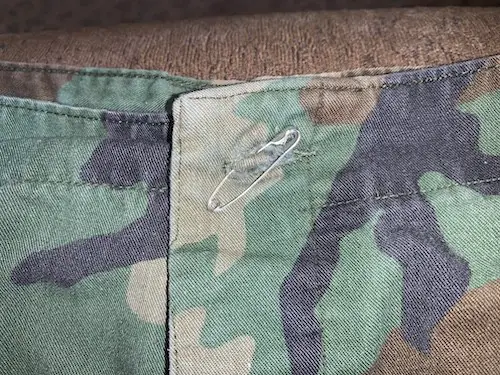
Buttons always seem to fall out at the worst possible moments. Safety pins work very well to replace a lost button or serve as one until you can sew the old one back on. Run the needle end of the safety pin through the fabric where the old button was sewn on and close it. It can then be used to secure pants or jackets as the old button did. Just don’t poke yourself if the safety pin opens on accident.
Hemming Clothes
Safety pins work well to repair hems and create temporary ones. If you have a hem that comes loose on an article of clothing, you can use a few safety pins to repair it. This works well whether you are in a survival situation or need to look good for a meeting.
You can also use safety pins to create temporary hems. This is a good idea if you want to fold up clothing to prevent it from getting wet or from getting caught up in a tool or machinery. Fold the pants, jacket, or other item to the desired length and use a safety pin to keep it in place. This will allow you to work without having to constantly readjust sleeves or pants legs.
Make Gaiters
If you are in an area with ticks, chiggers, or other itchy or parasitic bugs, closing off the bottom of your pants’ legs is a good idea. Gaiters are the best way to do this, but if you don’t have any, you can use safety pins as a substitute.
Wrap the pants legs as tight as you can around your leg. Then, use safety pins to keep them in place. This will give bugs less room to crawl up your leg.
Threading Needles
Sometimes threading needles can be very difficult. This is true when dealing with small needles or thick thread. A safety pin can help make this much easier. To do this, open the safety pin. Then, try to thread the needle as much as you can. Use the safety pin to poke the thread through the needle’s eye. When doing this, you may want to stick the sewing needle into something to keep it still.
Awl
Larger safety pins can also work well as an awl for creating holes in thick materials, such as leather and canvas.
Scribe
The pointy end of a safety pin can also work well as a scribe to make markings on hard materials. You can use it to scrape messages or notes on rocks, wood, and other materials.
Drying Clothes
Having wet clothes could be a big problem in a survival situation. Safety pins can be used to help you create a clothesline to help you dry them. Use paracord to create a temporary clothesline and use the safety pins to attach the clothing to it. You can also use them to attach clothing to the outside of your pack so that it will dry as you are traveling.
Repair Gear
Safety pins can also help you repair damaged gear, such as sleeping bags, packs, and tents. I had to use one to repair a sleeping bag with a split zipper. It was freezing cold, so having my feet sticking out wasn’t an option. The safety pin helped close the hole and prevented the split from getting bigger.
Temporary Belt
If you have to run from Russians, monsters, alien invaders, or even just an ex, having your pants fall down as you are trying to escape can be a very bad thing. The best thing for this is a belt, but if you don’t have one, a couple of heavy-duty safety pins can work as a substitute. Fold the pants’ waistband over on itself and secure it in place with the safety pins. Use one on each side for the best results.
Secure Bandages

Safety pins are excellent choices if you need to secure bandages. Wrap the wounded area with gauze or a clean bandana and secure it in place with the safety pin. The safety pin can be used for this purpose over and over again.
Emergency Sutures/Staples
This one makes me cringe just thinking about it, but safety pins can be used as emergency sutures or staples in a survival situation. Be sure that any safety pin that you use for this purpose is sterilized and free of rust. Sterilization can be done with rubbing alcohol or a lighter.
*Note: Only attempt this if you have medical knowledge. There are some situations where closing a wound isn’t necessarily the best idea. An improperly cleaned wound that has been closed up will become a breeding ground for infection.
Splinter Removal
Safety pins are excellent tools to remove splinters and other small objects that get under your skin. Be sure to sterilize the pin’s needle before you use it to remove the splinter or other object.
Create a Squirt Bottle

One very clever use of a safety pin is creating a squirt bottle. You can use it to irrigate wounds with clean water, however, I usually just use it to mess with my dog. To do this, use the pointy end of the safety pin to poke a hole in a water bottle’s cap. When you squeeze the bottle, water will shoot out of the small hole that you have created. This works best with the flimsier water bottles that come in large packages.
Arm Sling
If you injure your arm, you will need to immobilize it to prevent further damage. One way of doing this is to use a shirt or other garment and safety pins to create a sling.
Fold the garment into a triangle shape and place the middle of it under the elbow and forearm. Run the side of the sling closest to your body back around your neck and the other side up the front of your chest. Use the safety pins to combine the two ends together. If you are injured and don’t have help, it may be easier to assemble the sling when it is off your body.
Finger Splint
Safety pins are fairly rigid and that makes them good splints for broken fingers. Wrap the finger in a bandage and then place safety pins on either side of it. Wrap another bandage around the safety pins and finger to hold them in place. This will prevent the finger from moving and help protect it from accidental bumps.
Lancing Boils
If you have a boil or blister, you can use a safety pin to pop them. However, only do this if the blister is excessively large or painful. You may also want to pop a blister or boil if it is in a place that will become more irritated through the use of the affected area. Popping a blister or boil can result in infection, so only do it if necessary.
To use a safety pin to drain blisters or boils, first be sure that it is sterilized. Also, be sure to clean the blister and the skin around it. Then use the safety pin to pierce the blister. Apply ointment and a bandage to the area and monitor it to make sure it doesn’t become infected.
Clean Fingernails
Safety pins also work well to clean dirt and other stuff from underneath your fingernails. Use the pointy end to scrape it away. In addition to making your fingernails look nicer, it can also help you avoid becoming sick.
Gear Attachment
You can also use safety pins to attach gear to bags or pouches. This is especially useful for smaller items, such as flashlights, that you want to keep handy so you don’t have to dig to find them. You can also use this method to attach solar chargers to your pack so they will absorb energy as you travel. Be sure to use heavy-duty safety pins for this and check frequently to make sure you haven’t lost anything.
Gear Organization

Safety pins also work well to keep small items organized. Items such as zip ties and fish hooks have holes at the top of them which you can use to secure them to a safety pin. This will keep them all together, reducing the chances that they will get lost or cause a mess in your bag.
Lock Picks
Safety pins can also serve as makeshift lock picks. For this, be sure to use the heavier-duty safety pins so that they won’t bend excessively while in use.
I have covered how to use paper clips and bobby pins as lock picks in other articles. Much of that information can be applied to safety pins as well. You can see those articles by clicking below.
Zip Tie Shim
Sometimes you want to reuse a zip tie without cutting it, and a safety pin works really well for this. Use the safety pin to move the zip tie’s locking tab out of the way. This will allow you to pull the rest of the zip tie through the lock and reuse the whole thing.
Click here to see my article, Survival Uses for Zip Ties.
Defense
I hope I am never in a situation where I have to rely on a safety pin to defend myself, but in a pinch, they are better than nothing. Larger safety pins can be used to pierce sensitive areas on an attacker.



